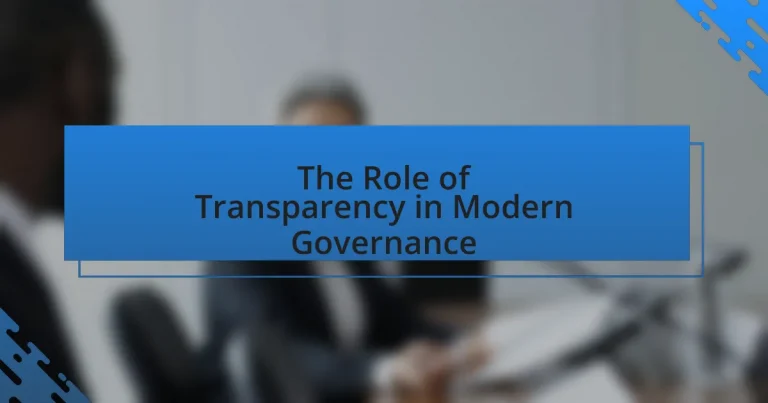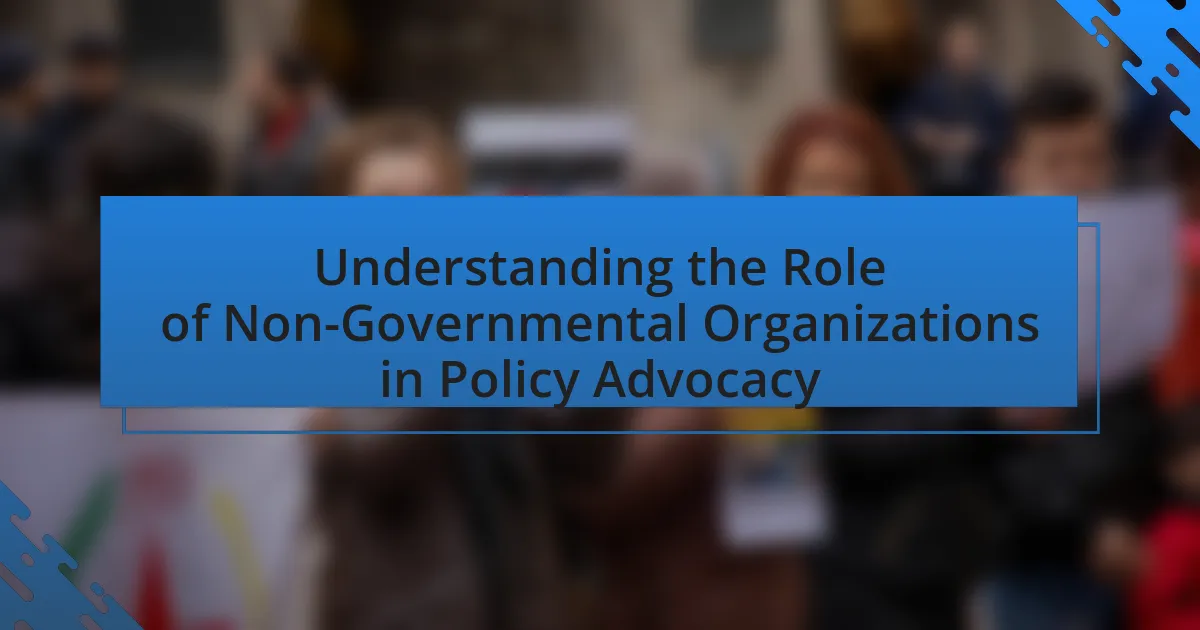The article examines the critical role of transparency in modern governance, emphasizing its importance in enhancing accountability and building public trust. It outlines key principles of transparency, such as accessibility, clarity, and participation, and discusses how these principles influence decision-making processes and policy outcomes. The article also addresses the challenges and risks associated with transparency, including information overload and resistance from institutions, while highlighting best practices and the potential of technology to facilitate greater transparency. Furthermore, it explores future trends in transparency, emphasizing the significance of citizen engagement in fostering effective governance.

What is the Role of Transparency in Modern Governance?
Transparency in modern governance serves to enhance accountability and build public trust. By making information accessible, governments enable citizens to scrutinize actions and decisions, which can lead to reduced corruption and improved policy outcomes. For instance, the Open Government Partnership, established in 2011, promotes transparency initiatives in over 75 countries, demonstrating that increased openness correlates with better governance practices. Studies show that transparent governance can lead to higher citizen engagement and satisfaction, as evidenced by research from the World Bank, which indicates that transparency fosters a more informed electorate and encourages civic participation.
Why is transparency considered essential in governance?
Transparency is considered essential in governance because it fosters accountability and trust between the government and its citizens. When governmental processes and decisions are open to scrutiny, it reduces the likelihood of corruption and mismanagement, as evidenced by studies showing that transparent systems lead to better public service delivery and increased citizen engagement. For instance, the World Bank has reported that countries with higher transparency levels experience lower corruption rates, which directly correlates with improved economic performance and social stability.
What are the key principles of transparency in governance?
The key principles of transparency in governance include accessibility, clarity, accountability, and participation. Accessibility ensures that information is readily available to the public, allowing citizens to access government data and decisions. Clarity involves presenting information in a straightforward manner, free from jargon, so that it is easily understood by all stakeholders. Accountability requires that government officials are answerable for their actions and decisions, fostering trust and integrity in public service. Participation encourages citizen engagement in the decision-making process, ensuring that diverse perspectives are considered. These principles are supported by various frameworks, such as the Open Government Partnership, which emphasizes the importance of transparency in enhancing democratic governance and public trust.
How does transparency influence public trust in government?
Transparency significantly enhances public trust in government by fostering accountability and openness in decision-making processes. When governments provide clear information about their actions, policies, and expenditures, citizens are more likely to perceive them as trustworthy and legitimate. Research conducted by the World Bank indicates that higher levels of transparency correlate with increased citizen engagement and satisfaction with government performance. For instance, a study published in the Journal of Public Administration Research and Theory found that transparency initiatives, such as open data platforms, lead to improved perceptions of government integrity and effectiveness. Thus, transparency serves as a critical mechanism for building and maintaining public trust in governmental institutions.
How does transparency impact decision-making processes?
Transparency enhances decision-making processes by fostering trust and accountability among stakeholders. When decision-makers operate transparently, they provide clear information about their actions and the rationale behind them, which encourages informed participation and reduces uncertainty. Research indicates that organizations with high transparency levels experience better collaboration and more effective problem-solving, as stakeholders feel empowered to contribute their insights. For instance, a study published in the Journal of Business Ethics found that transparency in corporate governance leads to improved stakeholder engagement and satisfaction, ultimately resulting in more sustainable decision outcomes.
What are the mechanisms through which transparency affects policy-making?
Transparency affects policy-making through mechanisms such as enhanced accountability, improved public trust, and increased stakeholder engagement. Enhanced accountability occurs when government actions are open to scrutiny, leading to a reduction in corruption and misuse of power, as evidenced by studies showing that transparent governance correlates with lower levels of corruption in various countries. Improved public trust is fostered when citizens perceive that decision-making processes are fair and open, which can lead to greater compliance with policies and initiatives. Increased stakeholder engagement happens as transparency invites public participation in the policy-making process, allowing diverse perspectives to be considered, which has been shown to result in more effective and inclusive policies. These mechanisms collectively contribute to more effective governance and better policy outcomes.
How can transparency improve accountability in governance?
Transparency enhances accountability in governance by allowing citizens to access information about government actions and decisions. When government processes are open and accessible, it enables the public to scrutinize officials’ conduct and decision-making, thereby fostering a culture of responsibility. For instance, studies have shown that countries with higher levels of transparency, such as Sweden and New Zealand, experience lower levels of corruption and increased public trust in government institutions. This correlation indicates that transparency not only empowers citizens but also compels officials to act in the public’s best interest, as their actions are subject to public oversight.
What challenges does transparency face in modern governance?
Transparency in modern governance faces several challenges, including information overload, resistance from institutions, and the risk of misinterpretation. Information overload occurs when excessive data is made available, making it difficult for citizens to discern relevant information. Resistance from institutions often stems from a fear of accountability, leading to reluctance in sharing information. Additionally, the risk of misinterpretation arises when complex data is simplified, potentially leading to misinformation and public distrust. These challenges hinder effective governance and the ability of citizens to engage meaningfully with their governments.
What are the risks associated with excessive transparency?
Excessive transparency can lead to several risks, including information overload, erosion of trust, and potential exploitation of sensitive data. Information overload occurs when stakeholders are inundated with excessive details, making it difficult to discern critical information, which can hinder decision-making processes. Erosion of trust may arise when transparency reveals inconsistencies or failures within an organization, leading to skepticism among stakeholders. Additionally, sensitive data may be exploited by malicious actors if overly transparent practices expose vulnerabilities, as evidenced by incidents where leaked information has been used for fraud or cyberattacks. These risks highlight the need for a balanced approach to transparency in governance.
How do cultural and political factors influence transparency levels?
Cultural and political factors significantly influence transparency levels by shaping societal norms and governance practices. In cultures that prioritize openness and accountability, such as those with strong democratic traditions, transparency is often higher, as seen in Scandinavian countries where public access to information is legally mandated. Conversely, in political environments characterized by authoritarianism or corruption, such as in certain regimes in the Middle East and North Africa, transparency is typically lower, as governments may suppress information to maintain control. Research by Transparency International indicates that countries with higher levels of press freedom and civic engagement tend to exhibit greater transparency, reinforcing the connection between cultural values and political structures in determining transparency levels.
How can transparency be effectively implemented in governance?
Transparency can be effectively implemented in governance through the establishment of clear policies, open data initiatives, and regular public engagement. Clear policies ensure that government actions and decision-making processes are documented and accessible, allowing citizens to understand how decisions are made. Open data initiatives, such as the publication of government spending and performance metrics, enable citizens to analyze and scrutinize government activities, fostering accountability. Regular public engagement, including town hall meetings and feedback mechanisms, encourages citizen participation and input, reinforcing the government’s commitment to transparency. Studies, such as the World Bank’s “World Development Report 2017,” highlight that transparency leads to improved governance outcomes, as it enhances trust and reduces corruption.
What best practices exist for enhancing transparency in government operations?
Best practices for enhancing transparency in government operations include implementing open data initiatives, establishing clear communication channels, and promoting citizen engagement. Open data initiatives allow the public to access government data, fostering accountability and informed decision-making. For example, the U.S. government’s Data.gov provides access to thousands of datasets, enabling citizens to analyze and understand government activities. Clear communication channels, such as regular public reports and press releases, ensure that information is disseminated effectively, while promoting citizen engagement through public forums and consultations encourages community involvement in governance. These practices collectively contribute to a more transparent and accountable government.
How can technology facilitate greater transparency in governance?
Technology facilitates greater transparency in governance by enabling real-time access to information and fostering open communication between governments and citizens. Digital platforms, such as e-governance portals and mobile applications, allow citizens to track government activities, budgets, and decision-making processes. For instance, the implementation of open data initiatives, where government data is made publicly available, has been shown to enhance accountability; a study by the World Bank found that countries with open data policies experience improved public trust and engagement. Additionally, blockchain technology can provide immutable records of transactions and decisions, further ensuring transparency and reducing corruption.
What are the future trends in transparency within governance?
Future trends in transparency within governance include increased use of technology, such as blockchain and artificial intelligence, to enhance accountability and data accessibility. Governments are adopting digital platforms to provide real-time information to citizens, thereby fostering greater public engagement and trust. For instance, the implementation of open data initiatives allows citizens to access government data easily, promoting informed decision-making. Additionally, there is a growing emphasis on participatory governance, where citizens are actively involved in policy-making processes, further enhancing transparency. According to a 2021 report by the World Bank, countries that prioritize transparency and citizen engagement experience improved governance outcomes and reduced corruption levels.
How might emerging technologies reshape transparency practices?
Emerging technologies such as blockchain, artificial intelligence, and big data analytics are reshaping transparency practices by enabling real-time data sharing, enhancing accountability, and improving access to information. Blockchain technology provides an immutable ledger that ensures data integrity and traceability, making it easier for stakeholders to verify transactions and actions taken by organizations. For instance, the use of blockchain in supply chain management allows consumers to track the origin and journey of products, thereby increasing trust. Artificial intelligence can analyze vast amounts of data to identify patterns and anomalies, facilitating proactive measures against corruption and inefficiency. Additionally, big data analytics empowers governments and organizations to present information in more accessible formats, fostering informed public engagement. These technologies collectively enhance transparency by making information more reliable, accessible, and actionable.
What role will citizen engagement play in the future of transparency?
Citizen engagement will be crucial in enhancing transparency by fostering accountability and trust between governments and the public. As citizens actively participate in decision-making processes, they can demand clearer information and hold officials accountable for their actions. Research indicates that increased citizen involvement leads to better governance outcomes; for instance, a study by the World Bank found that participatory governance initiatives can improve public service delivery and reduce corruption. This demonstrates that citizen engagement not only promotes transparency but also strengthens democratic processes and enhances the effectiveness of governance.
What practical steps can governments take to improve transparency?
Governments can improve transparency by implementing open data initiatives that make public information accessible to citizens. These initiatives can include publishing government budgets, spending reports, and decision-making processes online in user-friendly formats. For instance, the U.S. government’s Data.gov platform provides access to thousands of datasets, promoting accountability and informed public participation. Additionally, establishing independent oversight bodies can enhance transparency by monitoring government actions and ensuring compliance with transparency laws. Countries like Sweden have successfully utilized such bodies to foster trust and civic engagement.





